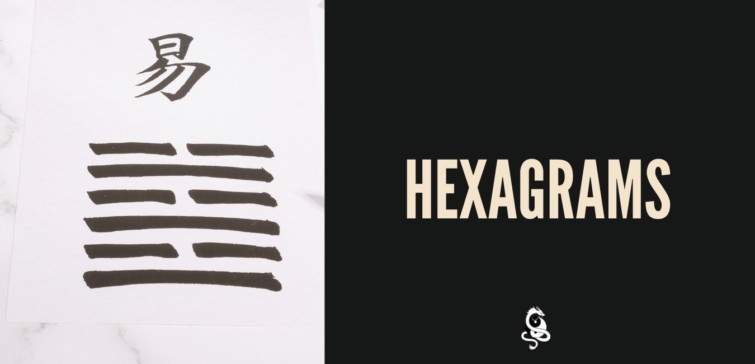Hexagrams Concept

EXPLAINING THE HEXAGRAMS IN SUMMARY FORM
Hexagrams are "models" used to express archetypes of situations in which human beings interact with the forces of nature or with each other. Initially, in the I Ching, they were represented only by a combination of 6 lines, one above the other, which can be continuous or not.
After this graphic representation, the ideograms were added (symbols or drawings that represents an object or an idea), the text of the Judgments (usually an advice for an ordinary human being), the text of the Images (usually an advice for an elevated human being), the study of what each position of the hexagram represents (each line is a position, being the lowest the 1st position and the upper line the 6th position) and the study of the sequence of the Hexagrams.
This material is that used for oracular study and, increased Confucian commentaries, for in-depth study.
EXPLAINING THE HEXAGRAMS MORE FULLY
In this text we will discuss how hexagrams were developed.
It is a beautiful story because of its content and respect between the authors that there was during the process.
The beginning of the story is mythical - so let's embark on this journey with an open mind!
A mythological being, named Fu Hsi, surprisingly received a sphere with 8 trigrams (3 lines, continuous or interrupted, placed one above the other): in the first version he received it through star beings, in the second through a turtle's hoof, and in the third from the mouth of a hippopotamus that emerged from the river.
With these 8 trigrams Fu Hsi understood everything!!! And, to make our lives easier (many laughs here!), he placed one trigram over the other exemplifying the 64 archetypal situations (human being interacting with nature and human being interacting with another human being).
At some point in history, ideograms (graphic symbols or drawings that represent an object or an idea) appear and become the titles of hexagrams. Over the years, these ideograms have undergone an increase or decrease of nuances or even radical changes, which were verified by archeological works. These changes occurred due to the influence of the understanding of the wise men of the societies or the social cultures.
Our story continues...
King Wen, who lived around 1,143 BC, organized the 64 hexagrams in the arrangement that is accepted today. This organization is used by authors such as Richard Wilhelm and Alfred Huang, among many others, and is discussed here under the heading SEQUENCE in each hexagram. The SEQUENCE texts show the reason why a hexagram precedes another specific hexagram.
King Wen addresses and develops the concept of how of the common man experiences a situation, but also begins to explore the concept of the superior man, who is a more virtuous man and always manages to act in an appropriate way, achieving a neutral or a positive outcome of the situation.
Then Duke of Chou adds the explanations of the hexagram lines. Each line represents a position in the hierarchy of society (people, leader of the people, sages of the people, upper class, leader of the nation, and sages of the nation) and, in the same way as Confucius, Duke of Chou goes on to evolve the concepts of the lower man, common man, higher being, wise men, and the great kings of antiquity.
Last comes Confucius who, as we know, has a rich philosophical production and makes many texts dedicated to the I Ching. He writes what today is known as the Ten Wings which are:
1st and 2nd Wings: T'UAN CHUAN - Comments on Decisions or Comments on the Judgments;
3rd and 4th Wings: HSIANG CHUAN - These are the images and comments on the lines written by Duke of Chou;
5th and 6th Wings: TA CHUAN or HSI TZ'U - The Great Treaty or The Great Commentary;
7th Wing: WÊN YEN - Commentary on the Words of the Text;
8th Wing: SHUO KUA - Discussion of the Trigrams;
9th Wing: HSU KUS - Sequence;
10th Wing: TSA KUA - Collection of Indications.
All these texts are covered in more in-depth courses.
And, repeating what was said above, it is amazing how these authors - Fu Hsi, King wen, Duke of Chou, and Confucius - do not argue with each other, they evolve the reasoning started by the previous author by complementing the idea.
Finally, the hexagrams, when used for consultation, are formed by the drawing of the 6 lines, the Ideogram, Judgment, Image and the study of what each position represents and, when used for a complete study, we use all the texts mentioned above and more some other texts complementary by Confucius.
LINK RELACIONADO E A ESTE POST